19" Rack Mount Equipment
© Brooke Clarke
2002 - 2023
Background
Horizontal Standards
Vertical Standards
Sub Modular
Depth Standards
Access
Stacking Instruments
Accessories
Safety
Shipping
Reusable Pallet &
Cardboard Box
Van with Power Lift
Portable Crate-Rite Rack
Mount Case
Fast Pack
Examples
HP Instrument Serial Number & Date Code
Air Transport Rack (ATR)
LackRack
Related
Links
Background
In the late 1800s when common battery telephone systems
were introduced the 19" rack was born. It's not clear if
this was the exact standard we have now. Later in telephone
service there was a need for wider racks but these maintained the
hole spacing now used on 19" racks.
It may have been in the 1930s and 1940s that the current standard
was established, see
here.
The specification is EIA-310-C "Racks, panels, and associated
Equipment".
There's also IEC 60297 Mechanics for Racks - 19 inch common
standard (DIN41494}.
Early on HP recognized that many of it's customers were mounting
their test equipment into 19" "relay racks". This is a
practical way to build a test system for many reasons. If a
test equipment manufacturer does not allow for this they are
eliminating sales.
Almost all "bench" instruments are designed to also allow rack
mounting. This may require removing the bench feet, carry
handle, rubber bezel or other enclosure parts and the addition of
a rack mount kit that typically contains the "ears" and other
hardware.
Horizontal standards
The space between the two vertical rack mount attaching
rails is 17 3/4". Any equipment that's rack mounted must be
narrower than this. The horizontal distance across the "rack
mount ears" on the equipment is 19". Instruments could be a
fraction of a rack width. The HP/Agilent 4395A Spectrum/Network/Impedance
Analyzer and the HP 54501A Digital Oscilloscope are 16 3/4" wide
and are full width instruments. The HP/Agilent 34401A Multimeter
is 8 1/4" wide and is 1/2 rack width. The HP 204 Audio Oscillator, HP 432 Power Meter and the 427A Voltmeter are all 5 1/8" wide or
1/3 rack instruments.
10-32 tapped holes 18.3" center to center on verticals.
There are mounting kits for all rack standard sizes of
instruments
|
Rack Width
|
Instrument width
|
|
full
|
16 3/4 (< 17.75)
|
|
1/2
|
8 1/4
|
|
1/3
|
5 1/8
|
|
1/4
|
3 5/8 ?
|
Vertical Standards
 The screw holes
in the rack are not all on the same center to center spacing, but
rather are repeating between 0.5", 0.625" and 0.625". This
works with a set of standardized panel heights that are all
multiples of 1 3/4" which is called 1 Unit high. All rack
mount equipment is an integer multiple of 1 Unit. The
location of the notches that pass the 10-32 mounting screws is
standardized for each panel height. Note that the location
of the notches is vertically symmetrical allowing the equipment to
be installed right side up or upside down.
The screw holes
in the rack are not all on the same center to center spacing, but
rather are repeating between 0.5", 0.625" and 0.625". This
works with a set of standardized panel heights that are all
multiples of 1 3/4" which is called 1 Unit high. All rack
mount equipment is an integer multiple of 1 Unit. The
location of the notches that pass the 10-32 mounting screws is
standardized for each panel height. Note that the location
of the notches is vertically symmetrical allowing the equipment to
be installed right side up or upside down.
1/2"- 5/8" - 5/8" repeating.
RU is from center of space in 1/2" gap
22 May 2008 - while trying to fit the FTS4060 into
a rack it appeared that the notches were in the wrong place.
But before cutting metal a through analysis of how panels can be
notched followed.
There are two
ways that the holes can be located in a panel. One way is to
have the edge of the panel centered between two holes that are
1/2" apart. The other way is to locate the holes so the
panel edge is centered between two holes 5/8" apart. Note
that the sum of the three cyclic hole spacings is 1.75" i.e. the
1U pitch. Because of that if one edge of a panel that is an
integer number of units high then the other edge will fall between
holes of the same pitch. The half the distance between two
holes 1/2" apart is 1/4" or 0.250 which is a nicer number than
half of 5/8" i.e. 5/16 or 0.3125" most panels center the edge on
the 1/2" holes.
Note:
If all the panels in a rack have been made on 1/2" or all
on 5/8" edges then they will stack one panel right next to
the one next to it. BUT, if you have two different
edge spacings then there will be a wider gap between
adjacent panels with different edge location layouts.
|
The holes are symmetrical top to bottom allowing for
installing a panel upside down.
When installing a panel the bottom two holes carry virtually all
of the torque that's trying to let the center of gravity of the
instrument rotate downward. If you install the bottom two
screws they will hold the instrument. But if you install
only the top two screws the bottom edge of the instrument will
tend to move away from the panel and if a heavy instrument may
break free. The loading on the bottom screws is minimized if
they are as far apart as possible. That's more important
than having more screws.
|
Units
|
Height inches
|
Edge centered on 1/2"
Notches from top inches |
Edge
centered on 5/8"
Notches from top inches |
|
1
|
1.75
|
1/4 1 1/2
|
5/16, 1 7/16
|
|
2
|
3.50
|
1/4 3 14
|
|
|
3
|
5.25
|
1 1/2 3 3/4 |
|
|
4
|
7.00
|
1 1/2 5 1/2 |
|
|
5
|
8.75
|
1 1/4 3 5 3/4 7 1/2 (4 holes)
1
or
1 3/4 4 3/8 5 (3 holes)
|
|
|
6
|
10.50
|
1.75, 3.34, 6.75, 8.75 |
|
|
etc.
|
etc.
|
etc.
|
|
Note 1 - corrected error 22 May 2008
Racks come in a number of heights from table top units to ones
that are just a little too tall to go through some door you need
to go through. When this happens it may be easier to take
apart the door frame than it is to take apart the rack loaded
with equipment. Some are just bare frames and others are
very fancy.
Sub Modular
HP made a number of instruments they called Sub Modular.
They are all 6 3/32" high.
They can be combined into a rack size using the 5060-0797 Adapter
Frame. When this is used it is not easy to add or remove
instruments.
They can also be easily combined using the Model 1051A Combining
Case. This case has flexible plastic retainers that can be
easily opened to allow an instrument to be installed or removed.
These retainers can also be moved horizontally to allow different
combinations of instruments to be installed. It will hold
three instruments that are 5 1/8" wide, which was a very popular
size.
Depth Standards
I'm not aware of any standards about depth.
Access
It may be important that someone can
get to the back and/or sides of the rack. In other cases a
rack can be pushed back against a wall.
This is something that needs some thought when the space is being
laid out. While working on a system it's best if the rack is
in the center of a room so you have access to all sides.
Stacking Instruments
Many of the HP instruments have a groove running left -
right along the top and the front bench feet have a tongue that
will fit into the groove of an instrument that was stacked below
it. The groove ends about 1/4" before each side so when
instruments are stacked they are interlocked both front to back
and side to side.
Instruments that do not have this feature tend to slide off the
instrument below them when you are connecting cables or
otherwise pushing on them. They typically don't make it to
the floor, but tend to stop after the feet are off the
instrument below them.
The term Rack and Stack is used to
describe the ability of combining instruments in an organized
manner and that's why I chose it as the name for my business of
building this type of system.
Accessories
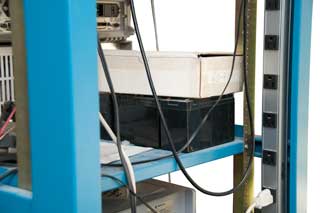
|
Outlet strip at right.
Just left of outlet strip are rear vertical rails.
Note ground pin up so that if something falls it will hit
ground rather than hot.
L-rail supporting instrument at top center.
Blue shelf supporting some Gel-Cell batteries.
|
Rails
Many racks built to hold electronic equipment also have a pair of
vertical rack mounting rails in the back. The most common
use of these is to install a couple of "L" section bars front to
back to act as a shelf to hold heavy equipment as it is slid into
and out of the rack. This makes is much easier to work with
heavy boxes.
These is also a way to get equipment into a rack that does not
have "ears" using a shelf, but the rack can not be shipped
because the equipment is not attached to the rack. Also
not good if in Earthquake country.
The rear vertical rack mount feature can be used to mount
equipment from the back side. If there is a front panel on
the equipment you typically want that facing forward, but if you
want to have a place to mount a lot of connectors, then
installing a panel on the back is great. Also AC power
entry panels and fans.
Blank Panels
Are used to fill up empty space both for appearance and in systems
where forced air cooling is used.
Outlet Strips
Mounted vertically at the rear of the rack provide a place to plug
in all the equipment. Two may be required if there's a lot
of equipment in the rack.
A comment on outlet strips in general. With
older tube equipment the spacing of "Plug
Mould" type outlet strips was many inches. These
could be mounted to a work bench and provided maybe one outlet
every 6 inches. This was OK when using tube equipment
because of the 15 Amp limitation on a single AC circuit.
With modern solid state equipment that draws very little current
you need as many outlets as you can get on the strip.
On older strips the sockets are arranged with the flats aligned
along the long axis of the strip. When a "wall wart"
transformer or power supply is plugged into this type of strip
it will cover one or two of the adjacent sockets. The
latest power strips turn the sockets so the flats are at right
angles to the long axis so that "wall warts" will go off to the
side. They also space the sockets to allow for this, or
maybe allow for one or two wall warts. You can also get
short "Y" cables for connecting wall warts to outlet strips.
Note ground pin up so that if something falls it will hit ground
rather than hot.
On-Off Switch
It's convenient to have a single On-Off switch for the whole
rack. That way you know the rack is turned off. Some
instruments do not have lights so without careful inspection you
don't know of they are on or off.
Power Panel
With older tube type equipment the power consumption of the total
rack typically exceeded the 15 Amp limit for a single A.C. power
cord so the rack might have a power panel that would take in 220
VAC, provide a main circuit breaker and feed the rest of the rack.
Fans
These were popular with tube equipment and could be mounted at the
bottom of the rack to blow the hot air out the top.
Custom Rack Kits
There are custom rack kits that are made to mount equipment that
does not readily take rack ears. For example a receiver that
was made to non standard dimensions or a computer monitor.
Keyboard Support
There are special 1 unit high supports for computer keyboards
Table
This is a table that sticks out the front and can be used to
support the unit under test, for a writing surface, etc.
Some can be extended.
Slides
These allow equipment to be easily pulled out of the rack and
sometimes rotated while out. Very handy for maintenance
and troubleshooting.
Safety
A rack loaded with equipment is very heavy. In
movies there's a murder where the victim dies when a bookcase full
of books is pushed over. If a rack is tipped it does not
need to go far in order for the center of mass to move outside the
base outline at which point it will be unstable and fall.
This is a real problem when slides are used. The center of
mass can easily get outside the base area and cause the rack to
fall forward.
I have an HP double wide rack which is on a base plate that
extends the base area forward so that slides can be used without
tipping over the rack.
Shipping
Reusable Pallet & Cardboard
Box
Agilent has a standardized way to ship a rack. It
is placed on a wooden pallet to allow a fork lift to move it.
Inside there is a wooden ramp that's hinged so that the rack can
be unloaded and reloaded onto the pallet. The cardboard side
and top covers are reusable and are attached using reusable straps
(as long as the straps are not cut).
Van with Power Lift
When I worked at Aertech HP
brought one of the first automated Network
Analyzer systems to our plant in Mountain View for a
demonstration. They had modified a panel truck so that the
rack was grabbed on the sides (about at the center of mass) and
could be lifted and rotated to slide into the truck, much like a
casket. This system used a 2116 HP computer with core
memory. At lunch the sales rep loaded a football game
where each player would pick a play: short run, long run, short
pass, long pass or field goal. The probability of the play
working was based on historical Cal vs. Stanford games,
the field position, down and some randomness. Good for
Monday morning quarterbacks.
Portable Crate-Rite Rack Mount Case
These provide a way to ship rack mount equipment that can be
reused and take up much less space than cardboard boxes.
This is a shipping case for rack mount electronic equipment.
There's a little more than 14" (8 rack units) height available.
It came with two installed "L" brackets (at about the center)
and four loose "L" brackets.
Also installed just below the "L" brackets are a pair of
equipment slides, but not the mating parts for the slides.
It appears that the two installed "L" brackets were holding a
piece of equipment between the bottom rails and the "L"
brackets, thus taking a lot of the load off the equipment
slides.
It sounds like a good idea to restrain equipment using the "L"
brackets at the top and bottom so that all the load is not taken
by front panel screws.
The equipment holes are not tapped and are oversize for a 10-32
screw. Clip-on metal nuts are installed where front panel
mounting screws will be used.
I've seen a PRC-138 radio and it's
associated power amplifier installed in a similar case, ready to
use.
Marked Manufactured by
Environmental Container
Systems
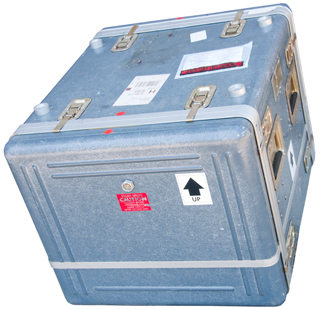
|
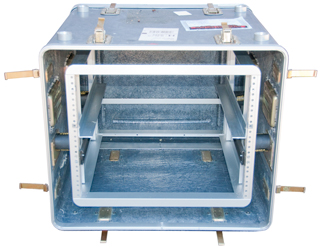 |
Clip for front mounting with 10-32 screws
Tell me where to get

|
Bottom Foot that mates with cylindrical
socket on top of another unit to allow stacking.
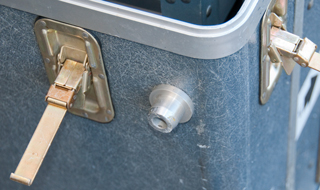
|
Spring backed 10-32 T-Nut to be used with
"L" brackets
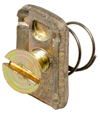
|
|
From ECScase.com
10-32 screws not included.
p/n: 47001440 Spring Backed T-Nut
p/n: 47001013 10-32 Nut with Clip

|
|
3482895
Protective Case for Electronic Instruments, Dennis M. Becklin,
Crate-Rite Inc., Dec 9, 1969, 312/352; 206/305; 206/594;
220/4.02; 361/730
The inner equipment rack is connected to the shipping shell with
shock mounts. Two or more cases can be stacked vertically
using the locating cylinders.
That way the equipment can be used while mounted in the case
just be removing the front and rear covers.
Fast Pack
There are a large selection of cardboard boxes lined with foam
designed to ship items with excellent packaging easily called Fast Pack. I've received them
in sizes from a book (GPS receiver) to pretty large holding rack equipment. These are
reusable.
Examples
Racks are also a good way to store rack size equipment.
Rack 1 - although you can not
see it in the photos two of these racks are side by side on a
common base with wheels
Rack 2 -
Time & Frequency Rack -
Racks are currently being used, they are not by any means out of
date. The Agilent E5022 Hard Disk Drive
Functional Test System and the Large Signal Network
Analyzer are both single rack systems I worked with as late as
2000. Many of the automated test systems I
built were in one or two racks.
Air Transport Rack (ATR)
When equipment is rack mounted in aircraft the ARINC 404 (Wiki)
specification governs the system.
ATR Size
|
Width
inches
|
Length
inches |
Dwarf
|
2.25
|
12.62
|
| 1/4 Short |
2.25 |
12.62
|
| 1/4 Long |
19.62 |
| 1/2 short |
4.88 |
12.62
|
| 1/2 Long |
19.62 |
| 3/4 Short |
7.50 |
12.62 |
| 3/4 Long |
19.62 |
| 1 Short |
10.12
|
12.62 |
| 1 Long |
19.62 |
1-1/2
|
15.38
|
19.62
|
An example of an ARINC 404 ATR is the one for the Collins PN-101 Pictorial
Navigation System, see Fig. 10
PS ARINC seems to have a problem with their math.
The 3/4 size is exactly 3 times the 1/4 size. But the other ratios
do not show integer relationships.
10.12 * 0.75 = 7.590 not 7.5
10.12 * 0.5 = 5.060 not 4.88
10.12 * 1.5 = 15.18 not 15.38
If you know why this is let me know.
LackRack
The wood Ikea
LACK side table is 22" square ($13 May 2022) and can be used
to mount rack equipment, i.e. the LackRack.
Related
Time & Frequency
Rack -
Rack 1 -
Rack 2 -
CEI Tempest Receiving
System - I rack named "TOBOR RADAR ROBOT" (Wiki: Palindrome)
Office Equipment
- not in rack, but rack type equipment that is just stacked.
Links
NovexComm
- makes rack mounting kits for a number of popular radios
Cooper B-Line
- 2 post network equipment racks
Bud Ind -
Hammond Mfg -
Knürr -
RackSonic - carries 19" to 23"
rack adapter ears
Back to Brooke's PRC68, Alphanumeric Index of web pages, Products for Sale, Military Test Equipment, Microwave Test equipment, Military Information, Personal Home page
Page created 29 Aug 2002.
 The screw holes
in the rack are not all on the same center to center spacing, but
rather are repeating between 0.5", 0.625" and 0.625". This
works with a set of standardized panel heights that are all
multiples of 1 3/4" which is called 1 Unit high. All rack
mount equipment is an integer multiple of 1 Unit. The
location of the notches that pass the 10-32 mounting screws is
standardized for each panel height. Note that the location
of the notches is vertically symmetrical allowing the equipment to
be installed right side up or upside down.
The screw holes
in the rack are not all on the same center to center spacing, but
rather are repeating between 0.5", 0.625" and 0.625". This
works with a set of standardized panel heights that are all
multiples of 1 3/4" which is called 1 Unit high. All rack
mount equipment is an integer multiple of 1 Unit. The
location of the notches that pass the 10-32 mounting screws is
standardized for each panel height. Note that the location
of the notches is vertically symmetrical allowing the equipment to
be installed right side up or upside down. 





